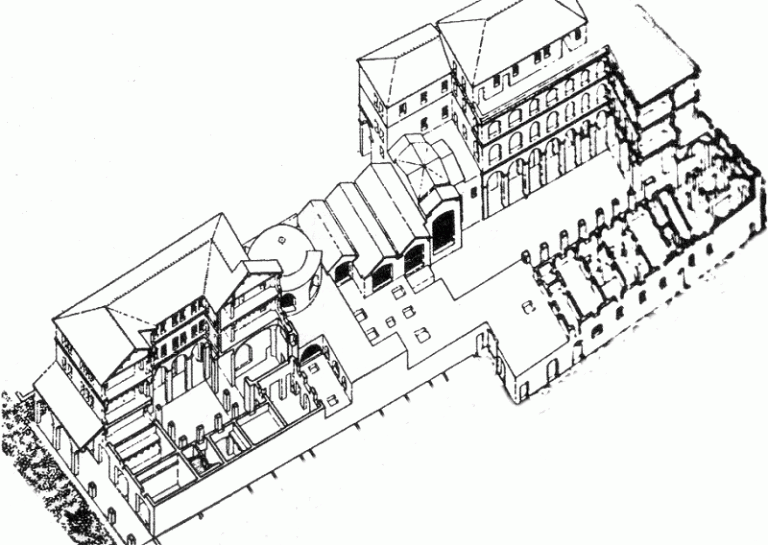In the Latin language, insula (plural insulae) means “island” and the term has been connected to the high-rise apartment dwellings of the Roman world, presumably since they rose like islands from the built landscape of the city. The insulae of ancient Roman cities provided housing for the bulk of the urban populace. The plebs—defined as ordinary people of lower- or middle-class status—tended to inhabit insulae. During the heyday of the mercantile city of Ostia at the mouth of the Tiber river (less than 20 miles from Rome), a building boom produced many such insulae, making Ostia a city of high-rise apartments, a phenomenon of urban building that would not manifest itself again until the Industrial Revolution.
History
In relating the history of the year 191 B.C.E., the historian Livy remarks that two tame oxen had climbed the stairs of a multi-story building, ending up on the tiled roof (Livy 36.37). While this may seem a passing comment, it reminds us that even in the second century B.C.E Rome was a vertical city in the sense that buildings with multiple levels were already being built. Strabo (5.3.7), commenting on Rome in the time of Augustus, mentions the building boom there and the need to regulate construction, including the height of buildings. The architectural writer Vitruvius (De architectura 2.8.17) expresses a fairly optimistic view of the insulae, observing that advances in construction technology that facilitated the construction of these outstanding dwellings. Other ancient authors, including Seneca and Diodorus, were less positive about insulae, seeing them as noisy and squalid.
There is some debate among scholars about how, precisely, we should understand and define the term insula. A fourth century C.E. source, known as the Regionary Catalog, states that in the city of Rome there were 44,850 insulae and 1781 domus in 315 C.E. Glenn Storey observes that if these figures represent individual buildings, fourth century C.E. Rome had over 45,000 independent structures. Understanding the meaning of the term insula, then, has obvious implications for understanding the population and organization of the ancient city of Rome. Scholars have debated how we should interpret the term. James Packer posits that insula connotes a high-rise building that could occupy an entire block or be a portion of a larger structure.
In this reconstruction, the larger building must have been subdivided into smaller units. These are the medianum and cenaculum, terms for subdivisions of the apartment building. Their specific meaning remains somewhat troublesome, but surviving records do indicate that apartment buildings were subdivided for legal reasons, as well as for assessing rent. James Packer estimates the median area of a Roman apartment at 239 square meters.
Typology
The apartment block differs significantly from the townhouse (domus). The domus is essentially a dwelling for a single, extended family unit, while the apartment block contains multiple units. The top-to-bottom arrangement of the Roman apartment block was the inverse of what is true in the twenty-first century: in the Roman world the best apartments were located at ground level, while the lower quality (and more squalid) units were to be found on the upper floors of the structure. There is a good deal of variation in terms of the organization of the structures themselves. Frequently the entire structure centers on an open courtyard which also serves as a light well for the lower floors. The spaces fronting on the street itself were often used for mercantile functions.
The port city of Ostia provides the best evidence for the Roman apartment block. Ostia had been founded as a Roman colony during the third century B.C.E. Its location at the mouth of the Tiber river was important for both mercantile and strategic reasons. During the second century C.E. its economy and population was booming, as was the population of the city of Rome. As a result the city witnesses an intense spate of building activity, including the construction of numerous insulae.
The Caseggiato del Serapide shows an example of a block with shops at the ground level, while staircases lead to apartments on upper floors. The courtyard contained a cult room with a stuccoed relief of the god Serapis.
The so-called Garden Houses (Case a Giardino) provide an example of second and third century C.E. luxury apartments that were later converted to commercial use. This structure originally stood to four floors (height of c. 17.70 meters or 60 Roman feet according to Stevens) and had 16 units on the ground floor. The central architectural feature is the garden courtyard at the center of the structure to which the apartments communicated.
The original walk-ups
The apartment block demonstrates the pragmatism and innovation of Roman architects who capitalized on their technical proficiency with concrete (opus caementicium). Cities like Rome and Ostia are unusual in the ancient world—their large and concentrated populations required solutions like the apartment block. These structures, despite Vitruvian enthusiasm, were not without their dangers and drawbacks. Since fire was a frequent danger in the ancient city, the high-rise apartment was particularly risky—especially for those dwelling on upper floors. The living conditions in some cases may have been less than ideal as well. The insula as an architectural type demonstrates the variety of Roman architecture and provides another set of important data about Roman domestic building.
Essay by Dr. Jeffrey A. Becker
Candela Citations
CC licensed content, Shared previously
- Roman Domestic Architecture (Insula). Authored by: Dr. Jeffrey A. Becker. Provided by: Khan Academy. Located at: https://www.khanacademy.org/humanities/ancient-art-civilizations/roman/beginners-guide-rome/a/roman-domestic-architecture-insula. Project: Roman Domestic Architecture (Insula). License: CC BY-NC-SA: Attribution-NonCommercial-ShareAlike





